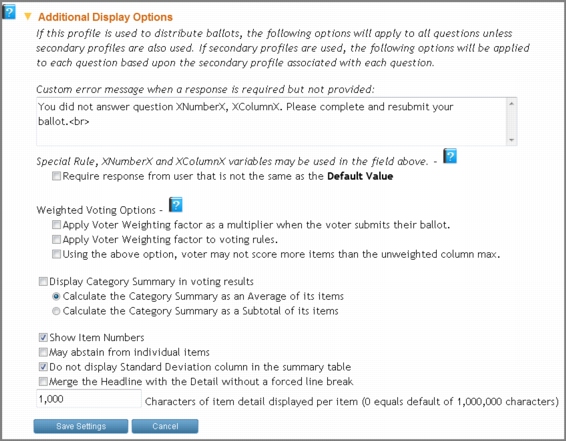|
Additional Display Options
|
Function
|
|
Custom error message when a response is required but not provided:
|
When using the checkbox option below to require non-default responses from a user you can designate a custom error message to be displayed for each question that has a response with a default value. The variable XNumberX and XColumnX may be used in the error message (e.g., You need to select a non-default value for Column XColumnX of Question Number XNumberX,). See also Special Rules instructions later in this section.
|
|
Require response from user that is not the same as the Default Value
|
Enabling this option requires that users select a response different from the default value for all questions. Using the option above you may customize the error message they receive if they provide a default answer to a question.
|
|
Apply Voter Weighting factor as a multiplier when the voter submits their ballot.
|
As ballots are submitted the votes are multiplied by the Voter Weighting set in the User Profile. The ballot voting rules are the same for all voters, that is, the ballot looks the same and controls such as Item Max and Column Max are the same for all voters. Voter weightings are not applied until after the ballot is submitted.
For example, if the Item Max is set to 5, a voter can cast up to 5 votes for an item. When the ballot is submitted the votes cast are multiplied by the voter weighting. If a voter casts a vote of 4 for an item and his/her voter weighting is 200, then the total votes tabulated for that item will be 200x4 or 800.
Voters should not be allowed to return to their ballots after submission, as the votes will have been changed according to their voter weighting.
|
|
Apply Voter Weighting factor to voting rules.
|
The Voter Weightings set in the User Profile are applied to the voting rules such as Item Max and Column Max when the ballots are created. Thus voters have different voting rules according to their voter weighting; some voters will be able to cast more votes than others.
For example, if the Column Max is set to 10 and a voter has a voter weighting value of 3, he/she can allocate a total of 10x3 or 30 votes.
|
|
Using the above option, voter may not score more items than the unweighted column max.
|
This option is used in conjunction with the one above and was designed for a special kind of voting process. The Column Max is multiplied by the Voter Weighting in the User Profile to determine the total number of votes a voter has. However, with this option, the unweighted Column Max also limits the number of items that a voter can vote for.
For example, if the Column Max is set to 10 and a voter has a voter weighting value of 3, he/she can allocate a total of 10x3 or 30 votes but is limited to voting for a maximum of 10 items.
|
|
Display Category Summary in voting results
|
Using the associated radio buttons this option displays either the subtotal or average of the items for each category in the voting results table.
|
|
Show Item Numbers
|
Displays the item numbering assigned to each item
|
|
May abstain from individual items
|
Adds abstain check boxes for all questions at the far right of the voting ballot.
If a voter checks the abstain box for an item, tabulation ignores the data for that item.
|
|
Do not display Standard Deviation column in the summary table
|
Hides the standard deviation in the voting results table.
|
|
Merge the headline with the detail
|
Displays questions or items as continuous text instead of displaying separate item headlines and item details.
|
|
Characters of item detail displayed on ballot (0 equals default of 1000 characters)
|
Limits the number of characters displayed in the item detail on the voting ballot.
Scroll bars allow users to view the entire text if it exceeds this limit.
|









 Additional Display Options - applied to all questions using a certain profile
Additional Display Options - applied to all questions using a certain profile


